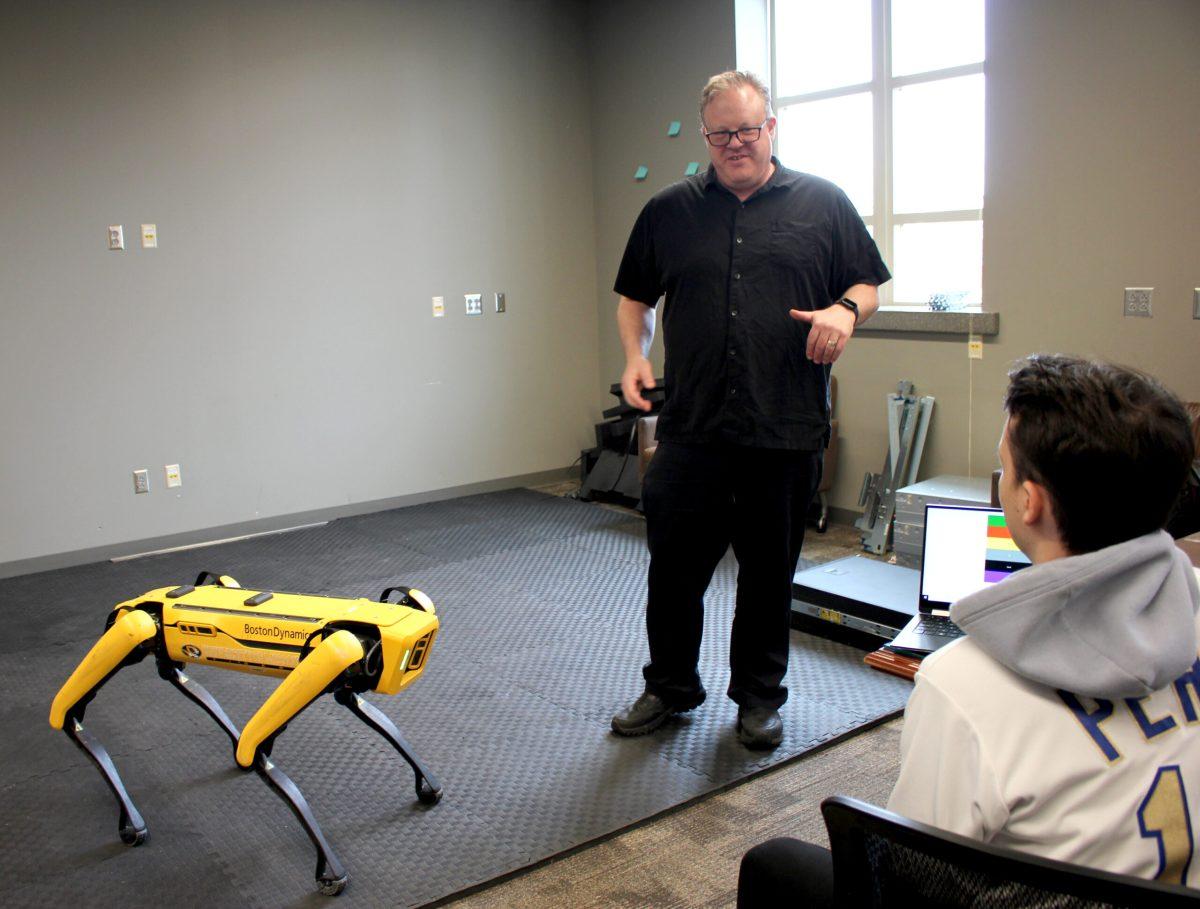
1st present, on date at name of building in Columbia, Mo. Past Kevin Brown (left) and Spot practice their performance on April 7, 2022 at Leffere Hall in Columbia, Mo. Conor Wood (right) controled Spot's responses to Brown's questions in preparation for "Hamlet: The King is Dead."
Shakespeare’s masterful plays on words are not rivaled by many authors of the modern age, but they are imitated by quite a few. This posse of authors attempting a Shakespeare-esque play on words has grown by one lately, in the form of artificial intelligence at MU. AI generated the new play, “Hamlet: The King is Dead,” with the help of MU Theatre professor Dr. Kevin Brown, and Spot, MU’s robot dog, will help Brown host the reading.
Brown works with AI called Generative Pre-Trained Transformer 3, which is software designed by EleutherAI that can make predictions. To create the play, he typed in a phrase to prompt the AI to find common themes on internet websites. GPT-3 used these themes to connect words, sentences and play script structures, and with a lot of editing (because robots do not always understand things like narrative structure), “Hamlet: The King is Dead” was born.
The prompt GPT-3 used to generate “Hamlet: The King is Dead,” is the very name of the play itself. Brown used two malleable metrics, the amount of data the AI “brain” chooses its response from and the randomness of that stream of data. It created what Brown called a “surrealistic play” due to its “stream-of-conciousness” feel.
“The robot would somehow tap into the vast internet resources of text that have been written about Hamlet and all of Shakespeare’s plays, and basically … it is using a neural network to create a statistical model,” Brown said.
The GPT-3 uses previous training and activity, hence the word “pre-trained” in its title, to predict what its user wants it to generate.
“It’s kind of like the predictive text on your phone,” Brown said. “Like it’s saying, ‘Based on these words, what are the most probable next words that are going to happen?’ and then it starts coming up with Shakespeare.”
Spot will communicate during the reading with physical movements, which senior engineering student Conor Wood will control offstage using his Python-coded interface. For instance, during a demonstration, Brown asked if Spot liked the food at MU. Wood used a button on the interface to prompt the robot to raise one side of its body in an inquisitive position, much like a dog tilting its head.
“Oh, I forgot,” Brown said jokingly. “You don’t eat!”
The interface runs on a computer connected to Spot via Wi-Fi connection. The screen has a series of buttons with commands such as “roll over” and “play dead.” Some commands like “sit” came pre-programmed from the creation company, Boston Dynamics, but others required more problem-solving and innovation.
For “play dead,”a command essential to any play resembling a Shakespearian tragedy, the robot lowers itself to the ground and twists to reveal its underside, just like a real dog would. Wood coded this motion with a combination of stock commands and unexpected functions like the battery-changing mode to create this puppy-like mechanical roll.
Wood says this problem-solving is one of the most rewarding parts of the process.
“Getting anything to work is really just very satisfying, and it just makes you feel very accomplished,” Wood said.
If you are apprehensive that Spot may be the performer or run around unprompted, you are not be the only one. Brown said that nervousness surrounding the robot is common. He said that culturally, Americans are wary of robots taking a larger role in society because of their negative portrayal in popular culture, such as “killer robots.” However, Brown has been intrigued by code and robots since childhood and wrote his master’s thesis and has published several articles in academic journals about the implications of robots participating in art and performance.
His main emphasis is the collaboration between humans and robots in the performance world and in their future careers. He hopes for a world where his students do not just accept robots as tools that serve them, such as Siri or Amazon’s Alexa, but that they will work with robots to accomplish what neither could alone.
“I’m even kind of challenging that by trying to think about ‘What are ways we can think of robots as our equals or as our collaborators?’” Brown said.
In a way, a lot of people have unknowingly collaborated with the AI to create this play. The AI cannot come up with ideas on its own; it relies on the human perspectives published online. Brown said he even considered crediting Shakespeare himself in the creation of the work since all ideas about “Hamlet” rely on his writing the play in the first place.
The performance itself also plays into Brown’s collaborative goal; it is compelled by the AI-generated creation but is carried by the voices of MU Theatre and Engineering faculty and students, who will be the ones reading the play. After the reading, Brown and Spot will demonstrate some of Spot’s new capabilities and answer questions together. To attend this original performance at 7:30 p.m. Saturday in Studio 4 at McKee Gymnasium, RSVP to [email protected]. Seating is limited.
Edited by Lucy Valeski, [email protected]